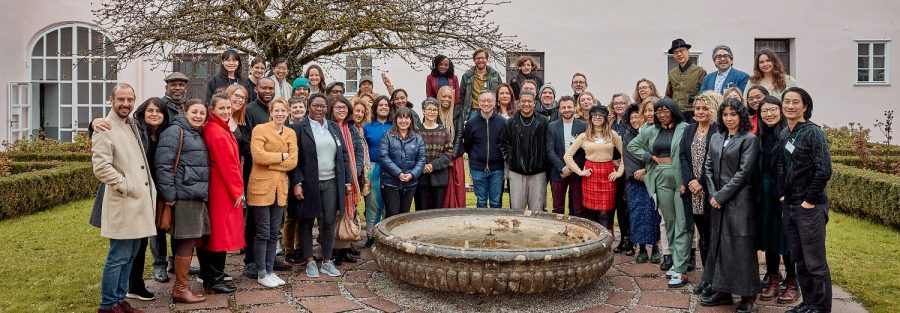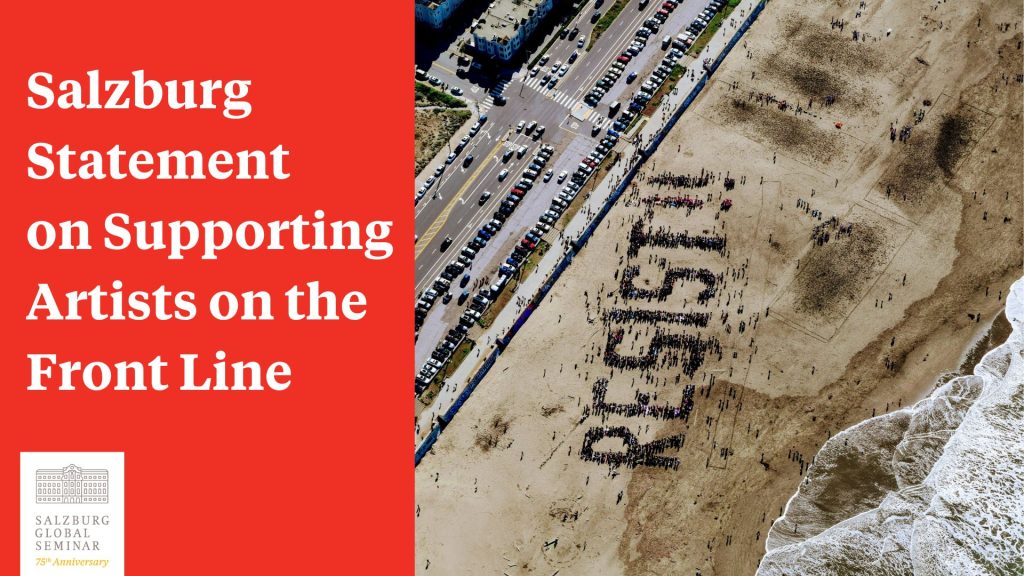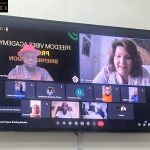The Salzburg Statement on Supporting Artists on the Front Line
Last year, Unchained Vibes Africa was represented at the Salzburg Global Seminar session ‘On the Front Lines: Artists at Risk, Artists who Risk’, where fifty artists, activists and representatives from supporting organisations which cut across forty countries created the Salzburg Statement on Supporting Artists on the Front Line.
The Statement is a concise document including definitions of artists at risk, artists who are persecuted due to their artwork, artists as activists or human rights defenders. It includes considerations and reflections for and on those who support art and artists at risk such as policymakers, funders, institutions, organisations in both arts and human rights sectors. The Statement clearly outlines demands and recommendations as well as a three-point call for action by the end of 2025 on the part of policymakers, funders, stakeholders and networks.
We ask you to support this initiative, take it to your policymakers, funders, stakeholder organisations, associations and networks, discuss it, distribute it and most of all, to demand discussions of it at conferences and meetings through 2024 with the aim to realize its vision.
CONSIDERATIONS AND REFLECTIONS
Policymakers need to address bias in cultural policy: Cultural policy can perpetuate systems and norms that contribute to the suppression of cultural rights and the right to artistic expression. To ensure that artists at risk have equitable access to support, policy and procedure must consider artists’ working and living conditions, especially but not limited to risks associated with racism, populism, unfair working conditions, gender discrimination, access to digital resources, and poverty. Such access must not discriminate by prioritizing standards of the most advantaged or historically dominant territories or populations. These goals can be addressed by establishing separate support programmes or by rewriting criteria for existing programmes to ensure substantive equality, and this needs to be done in full consultation with the target artists and arts organizations supporting them.
Evaluators and funders need to address bias in the appraisal of art made by artists at risk: In appraising the work of artists at risk, the interdisciplinarity and multi-sited nature of their work and lives must be considered during any appraisal of cultural worth. Assessments of art made by artists at risk must be informed by a comprehensive understanding of the intent, circumstances in which the artists create, and circumstances about which artists make their art.
Policymakers and the cultural sector need to integrate considerations of art made by artists at risk into cultural policy: The cultural sector shares a collective responsibility for the arts and artists to flourish and for the public to access, enjoy, engage with, and be stimulated by diverse artistic processes and products. The global cultural sector should be considered one body, the overall health of which is dependent on all of its parts. We call on all actors in the cultural sector to act in concrete solidarity with artists at risk, and those arts organizations working with them, whether digitally or in analogue. Creating a cultural sector that promotes freedom of artistic expression, cultural rights for all, and supports artists at risk should not happen through making a parallel cultural sector for artists at risk; rather, it requires a wholesale integration of new methods and resources into existing systems and institutions. Arts organizations and institutions that produce, present, and promote creative work in the culture sector need to examine their mission statements and programs and consider where and how they can support artists at risk, help amplify their voices, and help raise awareness of the public in the work of these artists. In doing so, they also need to consider new types of art and corresponding artists who have previously been excluded, including video game artists or artistic activists expressing themselves in virtual realities or “metaverses”.
Human rights and free speech NGOs and GOs must fully integrate considerations art made by artists at risk into human rights policy: Organizations and institutions that support human and civil rights, including government, private, and non-governmental institutions, policymakers, and funders, should recognize the critical role artists at risk play in upholding the values of civil society. Human rights policy should consider artists at risk as vulnerable not only on the basis of the violation of their civil and political rights, but also on the basis of the violation of their cultural rights, and their creativity as artists. Human rights and free speech organizations need to take concrete steps to make their policies, systems, and resources more accessible to artists at risk. Measures should include but not be limited to improving applications for funding and other resources to better accommodate and reflect the work and conditions of artists at risk, opening of such programs for new types of artists in the digital world which were previously excluded, as well as specific training for workers by specialists from the field.
Major arts institutions must strengthen and support smaller organizations: Strong arts institutions whose missions include cultural rights, diversity and pluralism, democratic values and freedom of artistic expression have a duty to look to their communities to not only reach out and build audiences for artists at risk, but also to support, in turn, existing smaller organizations that may already promote this work to more diverse audiences.
CALL FOR CONCRETE ACTION
By the end of 2025, we ask policymakers, funders and international, national, and regional stakeholder organizations and networks to:
- Facilitate a study of the factors and practices that inhibit, constrain, or ignore the creation, production, distribution, and documentation of the art of creative workers who have been or could be at risk due to their exercise of cultural rights and artistic freedom. This work must synthesize existing studies, analyze them and, most importantly, involve taking action with institutions with experience and a record of pioneering responsibilities in this regard.
- Create a comprehensive report detailing good practices for identifying, evaluating, and addressing the needs of creative workers who have been or could be at risk due to exercising their artistic freedom, in both the analog and digital realms. This report must outline the applicable duty of care owed to art makers by the organizations that support them and the standards for evaluating the work of those organizations.
- Introduce legal frameworks for Emergency Artistic Freedom visas that allow entry to identified receiving regions and nations and provide work authorizations of sufficient duration for creative workers who have been or could be at risk due to exercising their cultural rights, including their artistic freedom.
- Create and expand the allocation of financial and institutional resources to support and facilitate the relocation and ongoing professional development of creative workers who have been or could be at risk due to exercising their cultural rights and artistic freedom, including emergency residency facilities, especially in or close to the home regions of the artists. This allocation must recognize and include the creation and funding of financial and institutional resources to support and facilitate the short-term respite residencies and long-term creative development residencies for creative workers who have been or could be at risk due to exercising cultural rights and artistic freedom.
- Integrate artistic rights and cultural rights into international policy work and improve the visibility of cultural rights in the priorities of states and human rights NGOs. Include artists in all policies relating to them.
- Prioritize the collective expression and activities of artists as belonging in the human rights field, as important partners in finding solutions for sustainable development, democracy, and innovation.





